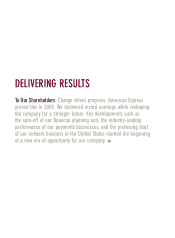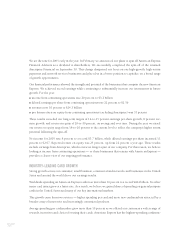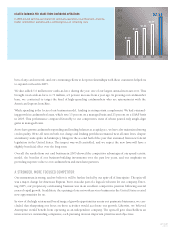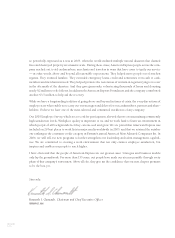American Express 2005 Annual Report Download - page 20
Download and view the complete annual report
Please find page 20 of the 2005 American Express annual report below. You can navigate through the pages in the report by either clicking on the pages listed below, or by using the keyword search tool below to find specific information within the annual report.
Private Bank holdings. Private Bank assets under management rose 10 percent, topping $20 billion for the
first time ever. In the Financial Institutions Group, global payment volumes increased by 21 percent.
The Bank continued its strategy of shifting resources to its higher-return, lower-risk businesses. Exiting
corporate lending over the past five years has significantly improved its return on equity and risk profile.
Additionally, the Bank continues to align its products and services more closely with the card business. Pri-
vate Bank services have become a key offering for Centurion cardmembers, and American Express cards are
available to clients as an integrated part of their relationship with the Private Bank.
MANAGING CHALLENGES
While we produced excellent results across our businesses in 2005, the question we — or any business for
that matter — must answer is whether we can sustain strong performance. We are confident the answer is
yes, based on our steady momentum since 2001 as well as the steps we have taken to increase our financial
strength and capitalize on our competitive advantages and growth opportunities.
Of course, no business operates in a vacuum. We, and the payments industry as a whole, face clear and
significant challenges into 2006 and beyond. I want to highlight three of them — discount rate pressure, the
uncertain economic environment, and industry saturation — and then explain why I believe American
Express is well positioned to navigate through these challenges and to execute our growth strategy.
DISCOUNT RATE PRESSURE ■Two factors have combined to focus attention on the fees that card net-
works charge merchants: regulatory actions in several countries and private merchant litigation, primarily in
the United States. While Visa and MasterCard have been the main target of these actions, we are not immune
from a spillover effect.
I’ll begin with the regulatory environment. In countries including Australia and Mexico, government author-
ities have scrutinized interchange rates set by the Visa and MasterCard networks and, in some cases, acted to
restrict them. The regulators’ actions have hinged on two principles: the notion that Visa and MasterCard
member banks are working collectively to set prices, and that because those associations have market power
they have substantially harmed competition.
American Express has not been directly affected by these regulations because we are fundamentally different
from our network competitors. We are a single entity, not an association of banks, and we set our discount rate
directly with each merchant. Although our network is open to other card issuers, they do not play a role in
setting merchant pricing. In addition, we do not have monopolistic power. Merchants are not required to accept
our cards, but choose to do so because we provide premium value in return for the fees we charge.
AXP / AR.2005
[18 ]
























